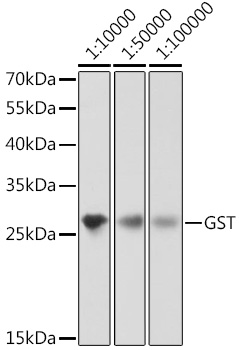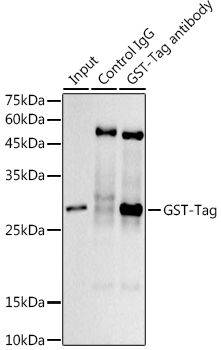GST Tag Mouse Monoclonal Antibody
| Cat Number: | MAB-91898 |
|---|---|
| Conjugate: | Unconjugated |
| Size: | 100 ug |
| Clone: | G8 |
| Concentration: | 1mg/mL |
| Host: | Ms |
| Isotype: | IgG1 |
| Immunogen: | Recombinant protein containing a sequence corresponding to amino acids 1-218 of GST protein. |
| Reactivity: | All Species |
| Applications: | Western Blot: 1:2000 – 1:5000 |
| Molecular Weight: | 27kDa |
| Purification: | Affinity purification |
| Synonyms: | GST;GST tag;GST-tag |
| Background: | Glutathione S-transferases (GSTs), previously known as ligandins, comprise a family of eukaryotic and prokaryotic phase II metabolic isozymes best known for their ability to catalyze the conjugation of the reduced form of glutathione (GSH) to xenobiotic substrates for the purpose of detoxification. The GST family consists of three superfamilies: the cytosolic, mitochondrial, and microsomal—also known as MAPEG—proteins. Members of the GST superfamily are extremely diverse in amino acid sequence, and a large fraction of the sequences deposited in public databases are of unknown function. The Enzyme Function Initiative (EFI) is using GSTs as a model superfamily to identify new GST functions.A GST-tag is often used to separate and purify proteins that contain the GST-fusion protein. The tag is 220 amino acids (roughly 26 KDa) in size, which, compared to tags such as the Myc-tag or the FLAG-tag, is quite large. It can be fused to either the N-terminus or C-terminus of a protein. However, many commercially available sources of GST-tagged plasmids include a thrombin domain for cleavage of the GST tag during protein purification. |
| Form: | Liquid |
| Buffer: | PBS with 0.02% sodium azide, 1.5% BSA, 50% glycerol,pH7.3. |
| Storage: | Store at -20℃. Avoid freeze / thaw cycles. |

Western blot analysis of over-expressed GST protein using Mouse anti GST-Tag mAb at different dilution.
Each lane was loaded with 2 ug cell lysate.
Secondary antibody: HRP Goat Anti-Mouse IgG (H+L) at 1:10000 dilution.
Blocking buffer: 3% nonfat dry milk in TBST.
Detection: ECL West Pico Plus.
Exposure time: 1s.

Immunoprecipitation analysis of 1 μg extracts of GST-Tag cells using 3 μg Mouse anti GST-Tag mAb antibody.
Western blot was performed from the immunoprecipitate using Mouse anti GSTTag mAb antibody at a dilution of 1:1000.
